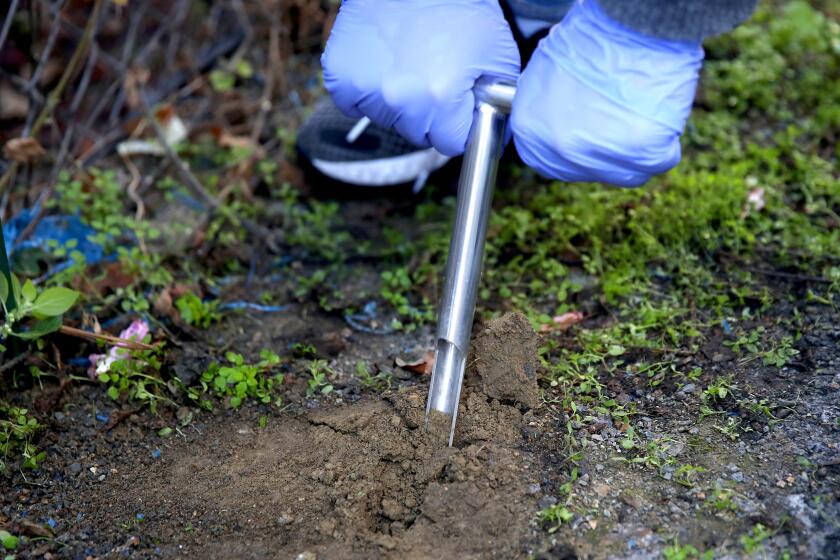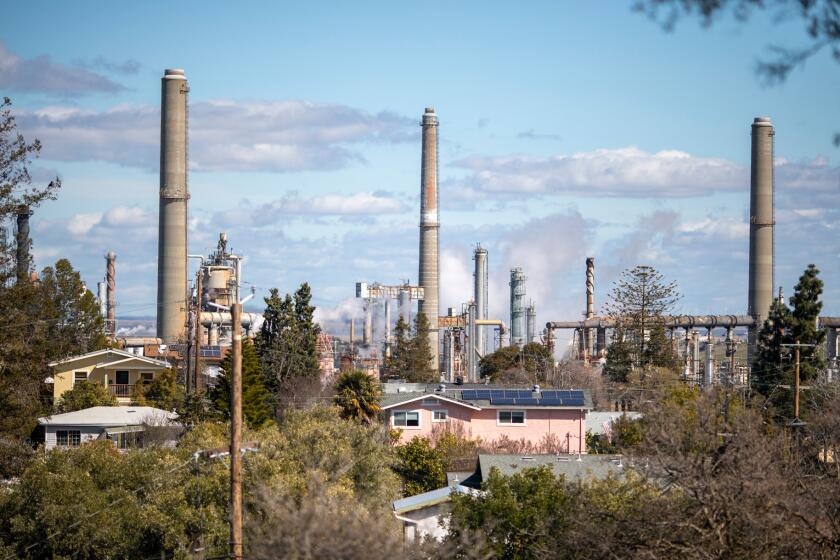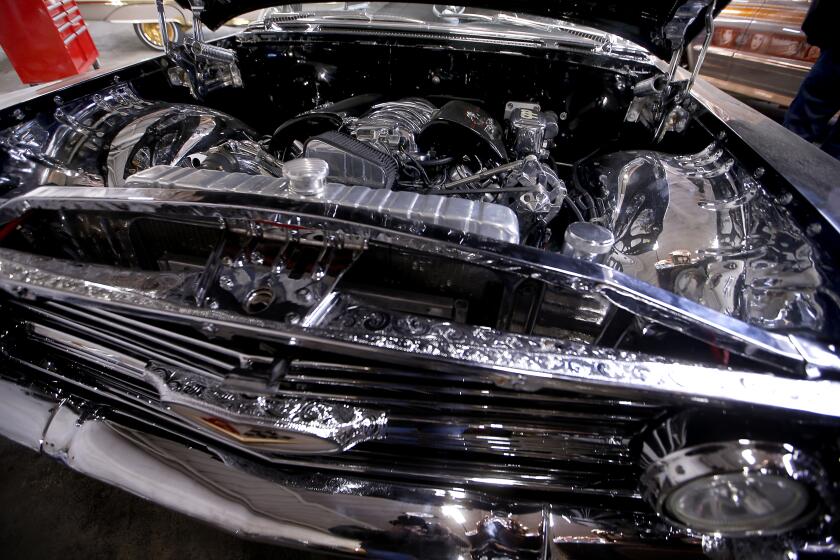In Boyle Heights, Sen. Alex Padilla urges Superfund status for Exide cleanup
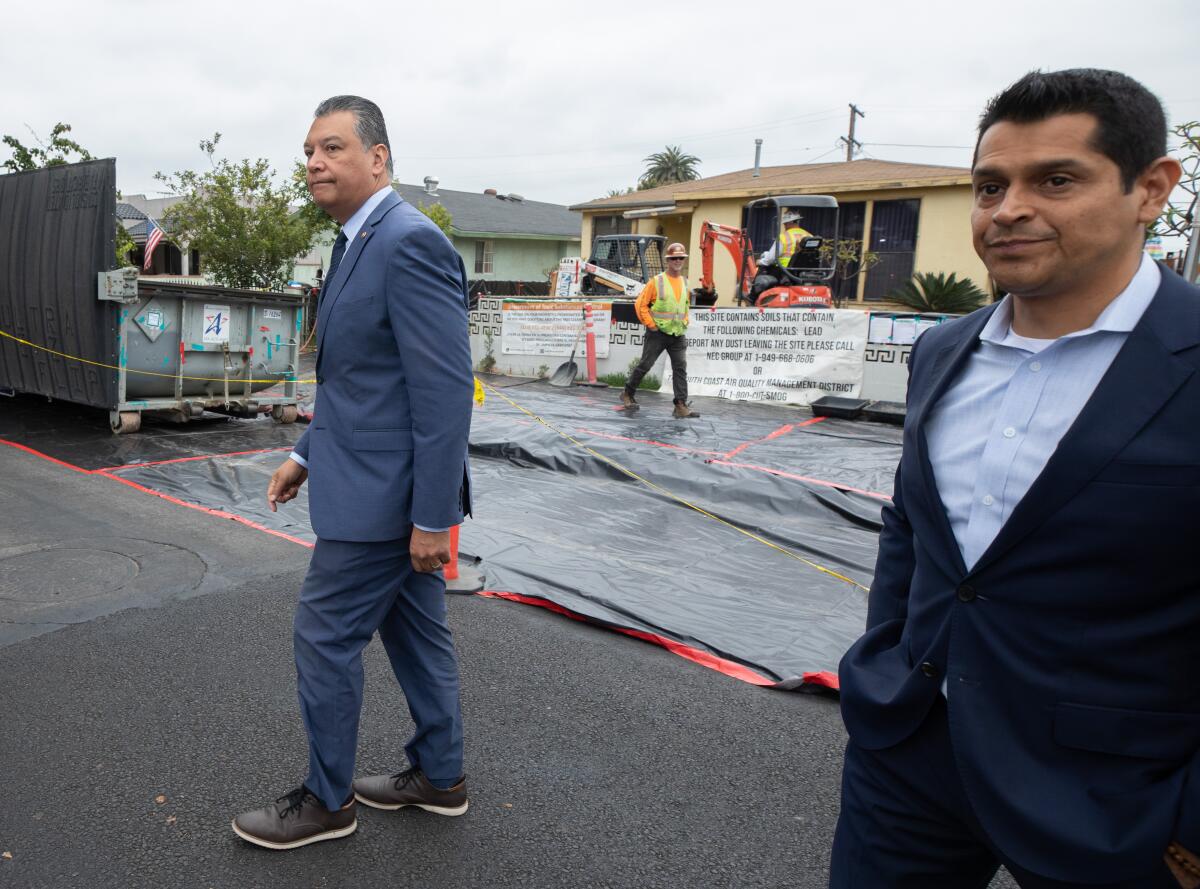
- Share via
With a torrent of criticism swirling around California’s largest environmental cleanup, U.S. Senator Alex Padilla Friday visited Boyle Heights and renewed his call for the federal Environmental Protection Agency to aid state efforts in removing lead contamination from neighborhoods surrounding a shuttered battery recycling plant in Southeast Los Angeles County.
Padilla (D-Calif.), along with Sen. Dianne Feinstein (D-Calif.) and Rep. Robert Garcia (D-Long Beach), sent a letter to EPA administrator Michael Regan in February asking him to expedite California’s request to designate areas near the former Exide plant as a Superfund site, a classification typically reserved for some of the nation’s most contaminated places. The designation, Padilla said, would bring in federal funds and likely expedite the pace of lead remediation efforts in the community.
Before closing in 2015, the Vernon plant had operated for nearly a century, melting down millions of lead-acid car batteries to repurpose the metal. After several bankruptcy filings, Exide, the most recent operator, left California taxpayers to foot the bill for the cleanup.
Numerous homes that underwent remediation have been left with lead concentrations in excess of state health standards, according to USC researchers.
As many as 10,000 homes surrounding the plant may have been contaminated by its lead and arsenic emissions, according to state officials.
In the past seven years, state-hired contractors have removed lead-contaminated soil from more than 4,600 properties nearby. Soil testing led by the University of Southern California, however, found many homes that had been cleaned by state contractors still contained elevated levels of lead.
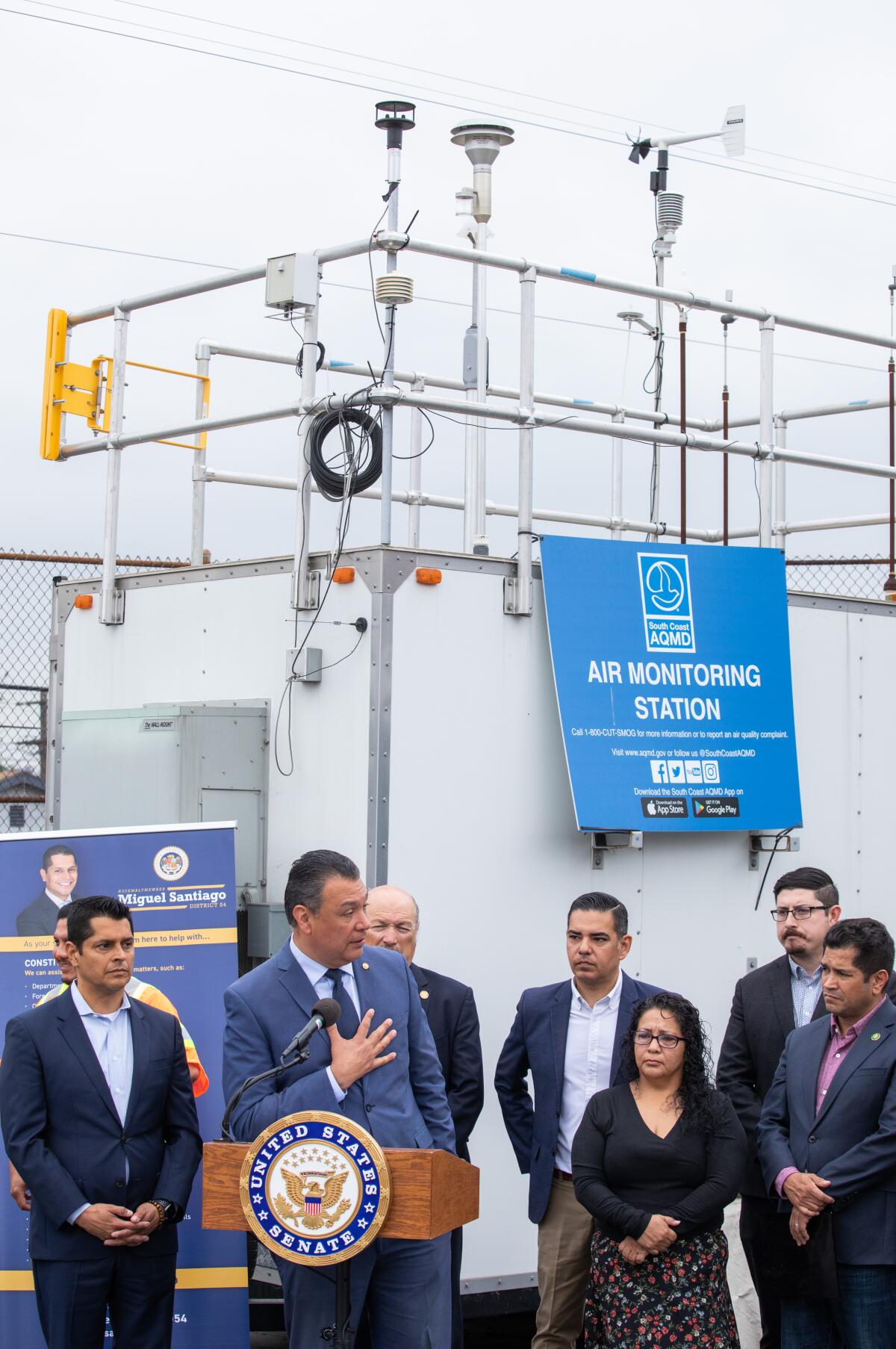
At a news conference held outside of Resurrection Catholic Church, Padilla unveiled a map illustrating two broad areas that the state is petitioning the EPA for Superfund status. The proposed area includes parts of Boyle Heights, Bell, Commerce, Huntington Park and Maywood.
“We’re calling for the EPA to step up — and to hurry up — because these families have waited more than long enough,” said Padilla, who was flanked by other lawmakers and community members.
The green-shaded region outlines the area California officials are asking the U.S. EPA to recognize as a Superfund site. (Courtesy of U.S. Sen. Alex Padilla’s office)
Padilla’s visit injected a sense of urgency into a massive $750-million cleanup, which some residents and environmental advocates have derided as slow-footed and insufficient by the state.
Padilla’s remarks offered the first glimpse into which areas the EPA might assume authority and provide assistance if the state’s bid for the Superfund designation is granted.
But some community members felt blindsided.
mark! Lopez, co-chair of the state’s Exide advisory committee, said Friday was the first time he had seen the map. Given the proposed Superfund sites are already located within the state’s cleanup zone, he fears any work performed by federal regulators won’t be additive.
“It doesn’t change the area that’s being cleaned up,” said Lopez, who is also a community organizer with East Yard Communities for Environmental Justice. “I’m just like, did they do any analysis beyond the existing cleanup area to justify not going further? It really just feels like they’re repackaging the exact cleanup that’s already problematic.”
Nearly six months after Martinez Refining Co. released hazardous materials, officials have announced reassuring soil test results.
Lopez said he had hoped federal assistance might go toward cleaning homes beyond the state’s 1.7-mile cleanup zone. USC-led testing found dozens of homes with high lead concentrations outside of the state’s cleanup boundaries. There was also an opportunity for the funds to be used to clean the railyard adjacent to the Exide site, which residents fear is heavily contaminated and may be a source of lead pollution on windy days, Lopez said.
The state toxics department has drawn the scrutiny of residents, activists and public officials for several aspects of the Exide cleanup.

At hundreds of properties, work crews failed to meet state cleanup standards, which outlined how much soil needs to be removed from properties, according to a Los Angeles Times investigation.
Some residents complained that state-hired work crews didn’t excavate any soil from certain parts of their properties. The California Department of Toxic Substances Control also lacked any plans to clean neighborhood parkways, the strips of public land that sit directly in front of most properties, despite having soil testing that showed they were heavily contaminated.
“There’s no doubt that every level of government has failed here for generations,” said Assemblymember Miguel Santiago (D-Los Angeles). “That’s the bottom line. There’s no excuse around it. For the county, city, the state, the feds — for 40, 50 years — did not address the worst environmental disaster on the West Coast that we now know is Exide, and our community has suffered greatly for it.
“And I’m not going to sugarcoat it,” Santiago continued. “There has been problems with DTSC [California Department of Toxic Substances Control].”
However, DTSC has recently overhauled parts of the cleanup. Following the Los Angeles Times investigation, the state has dedicated $67.3 million to clean neighborhood parkways and it has begun publishing reports that detail cleanup activities.
Padilla also tried to ease community concerns about federal intervention, given the EPA limit for lead in residential soil is five times higher than California’s health standard. Padilla said his office was advocating for the EPA to provide funds that would clean up properties to California’s more stringent threshold.
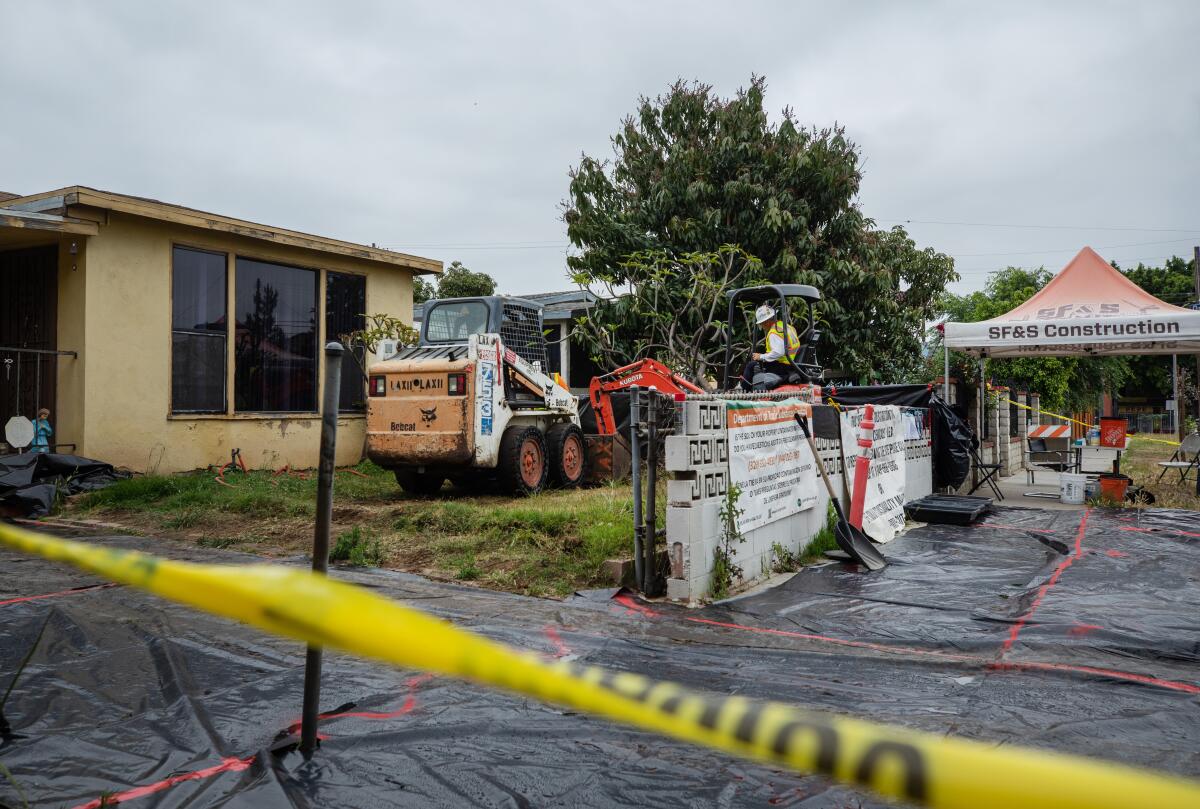
Earlier, Padilla stopped by a Boyle Heights home where a team of workers for SF&S Construction, one of the companies involved in the cleanup, were removing soil from the front yard of a home in the 1100 block of Esperanza Street. The yard had lead levels four times higher than the state limit.
As an excavator piled loads of polluted soil into a large metal container on the street, Padilla spoke with workers and Msgr. John Moretta, the pastor of Resurrection Catholic Church who has fought against pollution for decades. At the news conference, he said the community reminded him of the one he grew up in.
California air regulators have voted to phase out the use of a highly toxic metal that’s commonly used to restore classic cars and protect aviation parts.
“It’s hard to not feel outraged when you walk through the neighborhood and you see a true vibrant community — a community just like Pacoima … where I grew up in in the San Fernando Valley,” Padilla said. “You think of kids playing in the yards, you think of barbecues and cookouts on holiday weekends. And we think of too many people who are growing sick because of the contamination. Because, for decades, Exide dumped lead and other toxic contaminants into the community without consequence.”
Terry Gonzalez-Cano, whose family has lived in Boyle Heights for generations, said the toxic legacy left by Exide and the plant’s previous owners continues to haunt her because she used to encourage her two children to play outdoors when they were young, rather than watch TV or play video games. At the time, she and many neighborhood parents were unaware that dangerous levels of pollution were pervasive in their community.
“There were so many parents that — we just didn’t know,” Gonzalez-Cano said. “We took our kids to the park to play baseball and we had no idea they’re sliding into contaminated soil.”
“I know it’s not my fault,” she said. “But, as a mom, you take everything as your fault. That tears me up that I feel, in some way, that I was responsible for my kids getting sick.”
Gonzalez-Cano continues to live in Boyle Heights. And though her son and daughter are adults now, she says today it’s arguably harder to look outside on a pleasant summer day.
“There’s still kids playing in the dirt. And they’re still thinking that we’re not a priority.”
